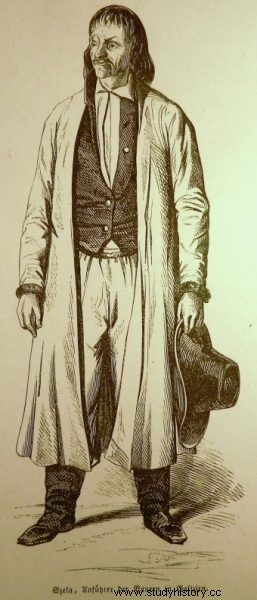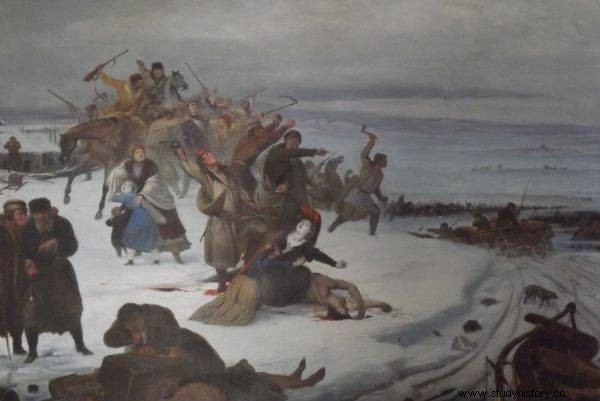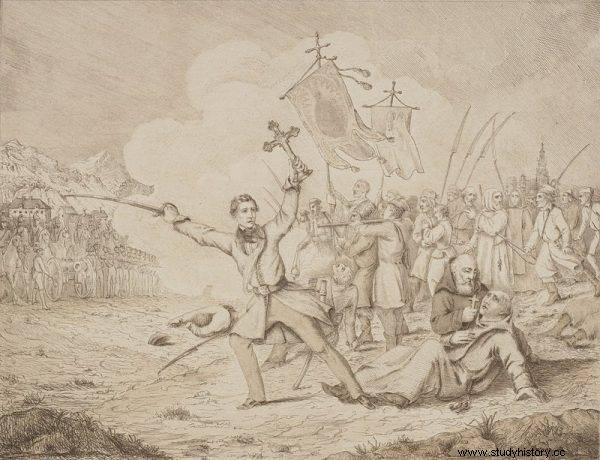In nineteenth-century Galicia, it was ruled by a lord and a parson. The peasant was to serve and be silent. However, it was boiling in the villages. A spark was enough to set your palaces on fire. The Austrians set this spark.
For a 19th-century peasant, the world usually ended after the last patch of field he worked on. The peasant was not interested in politics and for him Polishness was something completely abstract. There was no awareness of national distinctiveness among the peasants. The nobles and the Church were to blame for it, as they were more interested in enforcing feudal obligations than in educating the poor. In the mid-nineteenth century, the peasant was obliged to serve both church and noble property.

On February 18, 1846, Austrian agents informed the peasants that the nobility was gathering to murder them. The peasants, armed with axes, scythes and pitchforks, went to the courts.
The peasant of the time was almost entirely dependent on the upper strata of society. A nobleman, although not permitted by Austrian law, could flog a peasant, imprison him and even torture him . Many died after such crimping of the skin. Others have lost their health.
One of those mutilated was Jakub Szela, who was elected a representative of the inhabitants of the Smarzowa commune in a dispute with the owners of the property - Bogusz. It did not like the fact that the masses demand that any rights be respected. Szela was beaten many times, and in December 1845 arrested and mutilated again.
Chained, he was led barefoot and in only his underwear to the church, which he was not allowed to enter. Such participation in the mass ended up with frostbites and a cold which affected his health later.
The peasants who could not leave the village without the master's consent, were beaten and punished for every, even imaginary offense, were approaching the end of their endurance. Meanwhile, the nobility planned another patriotic spurt.
Nobility on the farm
The Polish nobility in the mid-nineteenth century did not understand the needs of the peasants and the middle class at all. The Sarmatian lifestyle and way of life still lingered, as well as the mythologized vision of a powerful Poland and the romantic desire to fight for its independence.
Polish emigration in France, known as the Great, was pushing the outbreak of the next uprising. Especially the conservative-landed faction, which gathered nobility within itself. At first, the emigrants were cherished and welcomed as heroes. Eventually they felt like this and turned to feathers .

Jakub Szela on a woodcut from 1848.
Soon, the French had the opportunity to learn about the nature of the Polish nobleman - bastard and adventurer. Political fights between the parties went beyond the pages of the press and leaflets, and moved to cafes and streets, where duels and drunken brawls began to take place. In such an atmosphere and with practically no understanding of the situation in Poland, it was decided to lead to an uprising.
Prussian and Austrian state services found out about the planned uprising quite quickly. While the Prussians only arrested emissaries and ringleaders, Vienna decided to get rid of most of the problems in one fell swoop.
Austrian spark
Vienna was perfectly aware of the relations prevailing in Galicia. Regular reports were sent, among others, by the starost of Tarnów, Joseph Breinlem von Wallerstern. He, too, being aware of the role of the nobility in the preparation of protests against the empire, incited the peasantry, hoping that, hoped that, by the abolition of serfdom, he saw the emperor as a defender of the oppressed . The truth was a bit different.

Initially, the emigrants were cherished and welcomed as heroes. Eventually they felt like this and turned to feathers.
The interference of imperial officials in the relations between the owner and the peasant was not so much to improve the land of the peasants, but to increase the state's income through more efficient tax collection. The peasants, who had been exploited and deceived by the nobility so far, began to see true defenders in the imperial officials, always willing to listen to their complaints. The imperial orders that came to the countryside through officials argued that the brightest gentleman remembered his peasant subjects. The peasants also understood that there was someone more important in the world than the owner of the village.
Rumors started spreading among the peasants that the gentlemen were going to introduce a new order and kill the rebellious. At the same time, the nobility was preparing against the Austrians.
First Blood
On February 18, 1846, Austrian agents informed the peasants that the nobility was gathering to murder them. The peasants, armed with axes, scythes and pitchforks, set off to the courts. After the first day, 144 victims were buried in Tarnów itself. Many of them died in front of the Tarnów starosty building. It was more profitable. For a dead nobleman, officials paid from 10 reni upwards. Only 5 Reins alive.
What horrors were going on in Tarnów! When they started taking them to Tarnów, the whole town was full of angry and armed peasants . They all abandoned them in front of the circus. Those who were still alive were killed by the cavalrymen with butts. The peasants were drilling their wounds with pitchforks, and the entire Tarnow audience, taken in despair, looked at it, and could not prevent it.
If Aunt Anusia Romer had not rushed to the Bishop and forced him with her insistence to resist such a terrible offense of divine and human rights as a servant of God, would be slaughtered to one. The bishop went to the starost, and Father Serwątski restrained the people with his speech, but they arrested him immediately - recalled Emma Stojowska .

After the first day, 144 victims were buried in Tarnów itself. Many of them died in front of the Tarnów starosty building.
Many wounded were found in hospitals in Tarnów. But no one really cared about them.
(...) in seven rooms several dozen wounded were lying. The sight of the latter was terrible, with their heads split open, with broken ribs, arms or legs, with bulging eyes, no jaws, no noses , they were lying in haste and raving to the great joy of such monsters as Żminkowski and Trojanowski, who chatted with a pencil in their hands to catch a word and write it down as incriminating evidence.
On February 20, 1846, Nicodemus and Wiktoryn Bogusz, who had been his oppressors for years, died at the hands of Szela.
The Battle of Gdów
Five days after the death of the Bogusz family, the nobility moved from Kraków through Wieliczka to Gdów. On the way, the First Riding Unit of Roman Pracki captured and interrogated a group of peasants. The commander wrote in his journal that:
robberies and murders committed by the peasants on the nobility, did not arise out of reluctance and revenge against them, but on the order of the district commissioner from Niepołomice and the starost of Bochnia who gave written orders to the heads of the nobility to add the nobility, living or dead; that for each person he will have 12 Rhenish silver (…).
After reaching Gdów, the nobility organized a feast, sprinkled with alcohol. The next day, February 26, Austrian Cheval Legers and peasants arrived in the city. The commander of the insurgents “Suchorzewski did not think about accepting the battle in Gdów, he simply did not expect such an imminent meeting (...). In the city - says one of the participants in the battle - they found the scythes drunk, and Suchorzewski went with a few gentlemen to a neighboring manor for a snack. Apparently, he did not appear on the battlefield at all. ”

Five days after the death of the Bogusz family, the nobility moved from Kraków through Wieliczka to Gdów. On the way, the First Riding Unit of Roman Pracki captured and interrogated a group of peasants.
Meanwhile, the cavalrymen and peasants caught up with the insurgents who were hiding under the cemetery wall. Michał Łysakowski, the later mayor of the Zwierzyniec commune, recalled:
(...) and then the peasants, howling like wolves, pounced on us to finish off and strip us . At that moment, however, an officer came running with a few infantry soldiers and shielded us from imminent death. Torn from my dress, bloodied to the waist, in the torrential rain that descended at the same time, I experienced benevolent help and sobriety. (...) I was taken to Wieliczka in the afternoon of the same day, where, after taking our shoes off, we were left to barrel like herring, packed in the municipal cellars. For 48 hours we got neither a piece of bread nor a straw for bedding.
154 insurgents died. 59 were captured. Austrians and peasants did not suffer any losses. The insurgents were so drunk that they only grazed one horse ...
The fall of uprising and robbery
The Battle of Gdów decided the collapse of the uprising. Thus, the peasants were no longer needed by the imperial officials. The military slowly began to calm the mood. Szela was interned in Tarnów. Soon he was given a 30-acre farm in the Romanian town of Bukovina as a gift. It was a kind of exile, but he was finally free.
During the five-week robbery , peasants plundered over 500 manors and over a dozen churches and presbyteries. 1,200 to 3,000 people died. Mainly landowners, administrators, court officials and several dozen priests. The peasants spared Jews, imperial officials and teachers.
The robbery has not been completed in many respects. It is true that the peasants were expropriated two years later, but it was still far from full equality. The robbery, however, left permanent traces in culture and economy. The nobility was shocked. Not only because of the brutality of the peasants, but also because of the prizes that were paid. The terrestrials did not notice that, in a way, they had driven the villagers to the breaking point themselves.
The robbery by the nobility was called the peasant rebellion and the memories most often mention the shoe and the surprise that the subjects dared to raise their hand against their masters. These events for decades defined Galician policy and strengthened the sense of bond among peasants, as well as awakened national aspirations. It was no coincidence that Galicia became the center of peasant political movements in the second half of the nineteenth and first twentieth centuries.
Bibliography:
- Dembiński S., 1846:chronicle of noble courts collected on the fifty-year anniversary of the sad events of February , Jasło 1896.
- Kieniewicz S., The peasant movement in Galicia in 1846 , Wrocław 1951.
- Leszczyński A., Folk history of Poland. History of exploitation and resistance. Reign Mythology , Warsaw 2020.
- Semczyszyn M., The crisis of the gentry in Eastern Galicia at the turn of the 19th and 20th centuries (until 1914) , [in:] "Scientific Journals of the Jagiellonian University", Historical Papers 146, 4/2019.
- Stojowska E., Memories of the robbery , "Wiadomości Literackie", Warsaw 1938, No. 40 (779).
- Szubert T., Some facts from Jakub Szela's life, "Kwartalnik Historyczny", 3/2013.
- Wielgosz P., Five hundred years of the camp. Homeland-serfdom , "Przekrój", June 2012.
